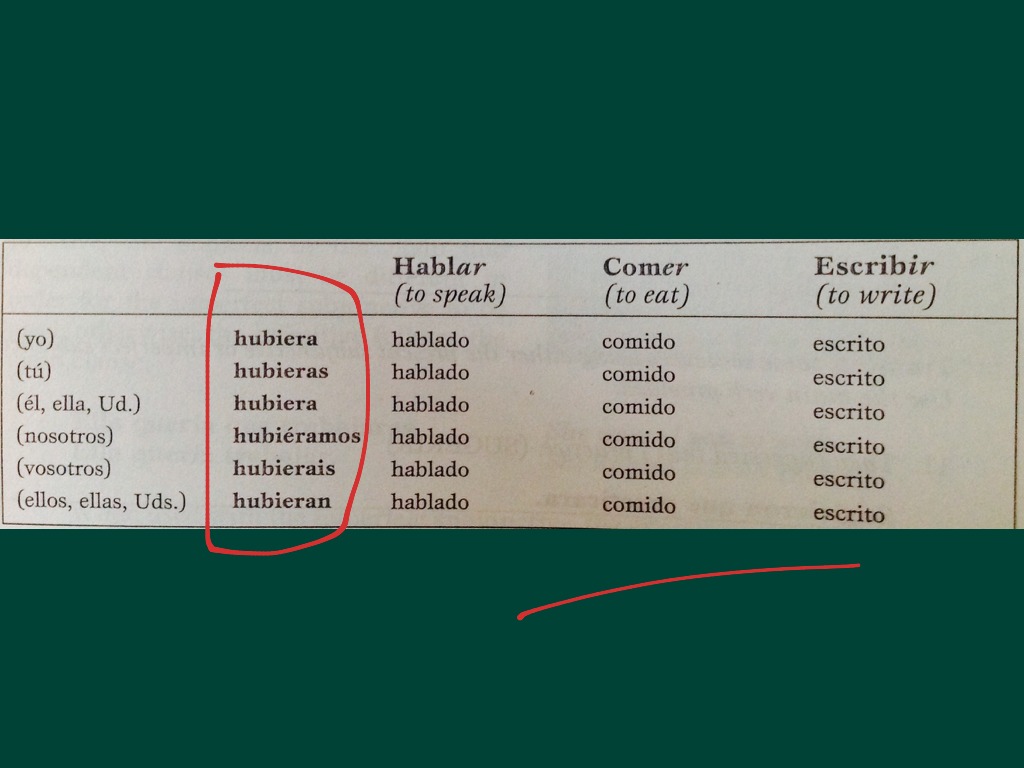

These conjugation patterns are only meant to help you communicate in the past. Additionally, we’ll go over time markers and conjugations.
#Past perfect spanish endings how to
You’ll also learn how to conjugate regular and irregular verbs and trigger words, among other things. How & When to Use the Preterite: This guide is meant to help you understand the most common uses of the preterite in Spanish.In this guide, you’ll learn the different contexts where you need to use them. Guide to imperfect vs preterite : These tenses are commonly confused among Spanish learners because they often share the same translation.Here are some resources you can check to improve your command of the Spanish past tenses: Next Steps: Past Tense Spanish Additional Resources – Describes past actions that were in progress. – Refers to actions that were interrupted by another past event. – Expresses that a past action took place before something else. – Talks about past habits or recurrent actions. – Activities that occurred at a specific time in the past. Here is a table where you can compare side by side the past tenses in Spanish: In other words, you need to understand how and when to use them.

These four past tenses are equally important to form coherent sentences. However, the imperfect focuses on events that happened for an extended period of time, whereas the past progressive refers to actions in progress. Take Note: Like the imperfect, the past continuous can also provide background information about the past.

When I left, Larry was cleaning the kitchen. This tense can be used to provide additional background information or to communicate that a past was interrupted by another one:Ĭuando me fui, Larry estaba limpiando la cocina. In Spanish, we use the past progressive (also called the past continuous) to express that an action was in progress at some moment (the event went on for a while). Mis hermanos ya habían terminado de comer. Sally had never gone to the beach before. This tense can also be used to talk about first-time experiences: Use the past perfect when explaining that a past action happened before something else. Take Note: The preterite and imperfect are usually confused with each other because they share the same translation. For example:īecause it refers to specific moments, the time markers for the preterite tense are words such as ayer, la semana pasada, hace dos años, etc. As a result, we use it to refer to finished actions or events that took place at a specific moment in the past. In Spanish, the preterite tense is the equivalent of the simple past. However, this tense is only used when referring to past habits or descriptions. Take Note: In English, the imperfect tense can be translated as ‘used to’ or ‘was’. Some time markers that work with tense are: In simple terms, to describe past circumstances or how something used to be. When it comes to past tenses in Spanish, the imperfect is used to provide background information. However, they differ in how they convey the message and what they focus on.īelow is a more detailed explanation of when and how to use each tense: Past imperfect When to Use Different Spanish Past TensesĪs their name suggests, Spanish past tenses convey that an action occurred in the past. Take Note: Even though it refers to an action that started in the past, the present perfect is often not considered a past tense because it also refers to or has relevance in the present. In the sections below, you’ll learn more about these differences. The past participle in Spanish is formed with the endings -ado (AR verbs) and -ido (ER and IR verbs).Īlthough they all refer to the past in Spanish, each of these tenses is used in specific situations. In other words, the formula for this tense is haber in imperfect form + past participle. The Spanish past perfect tense is formed with an auxiliary verb and a past participle. To make things easier, I’ve included real-life examples and additional resources to help you master this topic. To become conversationally fluent, you cannot overlook any of the Spanish past tenses. Additional Resources to Talk in the Past.How to Conjugate Past Tenses in Spanish.As a result, in this past tense Spanish guide, you’ll learn: But there are different conjugation patterns you can use. Using the past form is crucial to talk about what happened a few minutes ago or share a memory.

Like in any other language, the past in Spanish is crucial for daily communication.


 0 kommentar(er)
0 kommentar(er)
